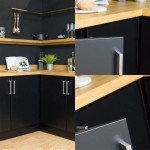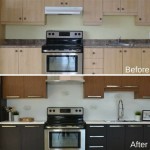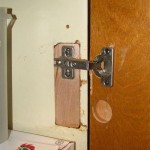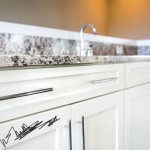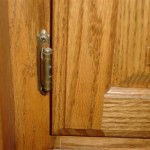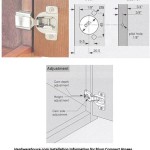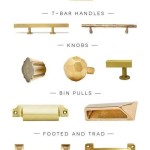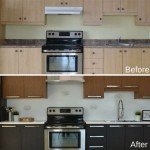Kitchen Cabinet Photo Ideas: Inspiration and Design Strategies
The kitchen, often considered the heart of the home, demands both functionality and aesthetic appeal. Kitchen cabinets, the dominant visual element in most kitchens, play a crucial role in achieving this balance. Exploring kitchen cabinet photo ideas provides a wealth of inspiration and practical understanding for homeowners embarking on renovation projects or new construction designs. These visual resources offer insights into material selection, color palettes, organizational strategies, and spatial planning – all critical components of a successful kitchen design.
Analyzing cabinet photos reveals current style trends and timeless design principles. It allows individuals to visualize how different cabinet styles and finishes interact with various countertop materials, backsplash designs, and overall kitchen layouts. This process facilitates informed decision-making, ensuring that the final design aligns with personal preferences, functional needs, and budget constraints.
Exploring Cabinet Styles and Aesthetics
Kitchen cabinet styles significantly impact the overall aesthetic of the space. Understanding the nuances of different styles is paramount in selecting cabinets that complement the desired look and feel. Shaker cabinets, characterized by their clean lines and recessed panel doors, offer a versatile option that suits both traditional and contemporary kitchens. This simplicity allows them to be paired with a wide range of hardware and finishes, adapting to various design schemes.
Flat-panel cabinets, also known as slab cabinets, present a sleek and minimalist aesthetic. Their smooth, uninterrupted surfaces are ideal for modern and contemporary kitchens, emphasizing clean lines and a streamlined appearance. They are often paired with minimalist hardware or push-to-open mechanisms to further enhance their understated elegance. The lack of ornamentation makes them easy to clean and maintain, a practical advantage for busy kitchens.
Raised-panel cabinets, with their ornate details and contoured doors, evoke a more traditional and formal aesthetic. These cabinets often feature intricate carvings and decorative moldings, adding depth and visual interest to the kitchen. They are well-suited for traditional and transitional kitchen designs, often paired with classic hardware and detailed countertops. The increased complexity can require more diligent cleaning to maintain their pristine appearance.
Glass-front cabinets offer a unique opportunity to display decorative items and create visual interest. They can be incorporated as accent pieces alongside solid-door cabinets or used extensively to create a brighter and more open feel. Consider the items to be displayed carefully, ensuring they are visually appealing and well-organized. Internal lighting can further enhance the display and create a warm and inviting ambiance. The glass doors require more frequent cleaning to maintain a spotless look.
Open shelving presents a less formal and more accessible storage solution. It is often used in contemporary and farmhouse-style kitchens to display everyday items and add a touch of personality. Open shelving requires careful organization and regular dusting to maintain a tidy appearance. The items displayed should be cohesive and aesthetically pleasing, contributing to the overall design rather than creating visual clutter.
Analyzing Material Choices and Finishes
The materials used in kitchen cabinets significantly impact their durability, cost, and aesthetic appeal. Solid wood cabinets, known for their strength and natural beauty, offer a timeless and durable option. Different wood species, such as maple, oak, cherry, and walnut, offer varying grain patterns and color variations, allowing for customization to suit different design preferences. Solid wood cabinets can be stained or painted to achieve the desired finish.
Plywood cabinets, constructed from layers of wood veneer, offer a stable and durable alternative to solid wood. They are less prone to warping and cracking, making them a suitable choice for kitchens with fluctuating humidity levels. Plywood cabinets can be finished with veneers, laminates, or paint to achieve the desired aesthetic.
Medium-density fiberboard (MDF) cabinets, made from compressed wood fibers, offer a smooth and consistent surface ideal for painting. MDF is resistant to warping and cracking, making it a cost-effective and versatile option. However, it is less water-resistant than solid wood or plywood and should be sealed properly to prevent moisture damage.
Laminate cabinets, featuring a decorative layer of laminate bonded to a core material, offer a durable and affordable option. Laminates are available in a wide range of colors, patterns, and textures, including wood-grain finishes. They are resistant to scratches, stains, and moisture, making them a practical choice for busy kitchens.
Paint finishes offer a versatile way to customize the color of kitchen cabinets. Painted cabinets can be easily updated to reflect changing trends or personal preferences. Consider the type of paint used, opting for durable and washable options designed for kitchen environments. The finish, whether matte, semi-gloss, or high-gloss, affects the overall look and feel of the cabinets.
Stain finishes enhance the natural beauty of wood grain, highlighting the unique characteristics of the wood species. Stained cabinets offer a warm and inviting aesthetic, often used in traditional and transitional kitchen designs. The stain color should complement the overall color palette of the kitchen, creating a cohesive and harmonious look.
Optimizing Storage and Functionality
Effective kitchen cabinet design goes beyond aesthetics; it prioritizes storage optimization and functional efficiency. Analyzing cabinet photos provides insights into innovative storage solutions and space-saving strategies. Pull-out shelves and drawers maximize accessibility and prevent items from being lost in the back of deep cabinets. These features are particularly useful for storing pots, pans, and other bulky items.
Corner cabinets often present a storage challenge. Lazy Susans and pull-out corner organizers maximize the use of space in these areas, providing easy access to items stored in the back. These features are especially beneficial in smaller kitchens where every inch of space counts.
Vertical dividers are useful for storing baking sheets, cutting boards, and trays, preventing them from cluttering countertops. These dividers can be customized to fit the specific dimensions of the items being stored, creating a neat and organized storage solution.
Spice racks and pull-out spice drawers keep spices organized and readily accessible. These features prevent spice jars from cluttering countertops or being lost in the back of cabinets. Consider the number and size of spices to be stored when selecting a spice rack or drawer.
Trash and recycling pull-outs conceal unsightly bins and prevent odors from permeating the kitchen. These features help maintain a clean and organized kitchen environment. Consider the size and number of bins needed when selecting a trash and recycling pull-out system.
Drawer dividers help organize utensils, silverware, and other small items. These dividers prevent items from shifting and creating clutter. They can be customized to fit the specific dimensions of the drawer and the items being stored.
Adjustable shelves provide flexibility in storage, allowing for customization to accommodate items of different heights. Adjustable shelves are particularly useful in pantry cabinets and other areas where storage needs may vary.
Consider the placement of cabinets in relation to appliances and work zones. Cabinets should be easily accessible from the stove, sink, and refrigerator, minimizing the distance required to retrieve items. This arrangement optimizes workflow and enhances the efficiency of the kitchen.
The height of upper cabinets should be carefully considered to ensure accessibility for all users. Lower cabinets should be designed to accommodate ergonomic considerations, minimizing bending and reaching. The depth of cabinets should also be considered, balancing storage capacity with ease of access.
Incorporating lighting within cabinets enhances visibility and creates a more inviting atmosphere. Under-cabinet lighting illuminates countertops and work areas, improving safety and functionality. In-cabinet lighting highlights displayed items in glass-front cabinets, adding a touch of elegance.
Analyzing kitchen cabinet photo ideas provides a comprehensive understanding of the various design considerations involved in creating a functional and aesthetically pleasing kitchen. By carefully evaluating different styles, materials, finishes, and storage solutions, individuals can make informed decisions that result in a kitchen that meets their specific needs and preferences. The visual resources available offer a valuable tool for planning, designing, and executing a successful kitchen renovation or new construction project.

64 Kitchen Cabinet Design Ideas 2024 Unique Styles

Kitchen Cabinet Ideas The Home Depot

Kitchen Cabinet Ideas The Home Depot

15 Stunning Kitchen Cabinet Designs In Singapore With 5 Essential Tips

15 Kitchen Cabinet Ideas And Trends For 2024

64 Kitchen Cabinet Design Ideas 2024 Unique Styles

80 Black Kitchen Cabinets The Most Creative Designs Ideas Interiorzine

14 Green Kitchen Cabinet Ideas 2024 Top Paint Colors For Kitchens

Kitchen Cabinet Ideas The Home Depot

Update Your Kitchen On A Budget Cabinets Decor Decorating Above Cabinet Design
Related Posts

